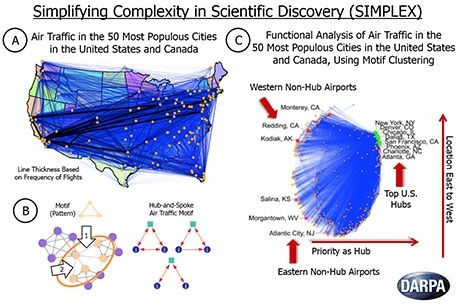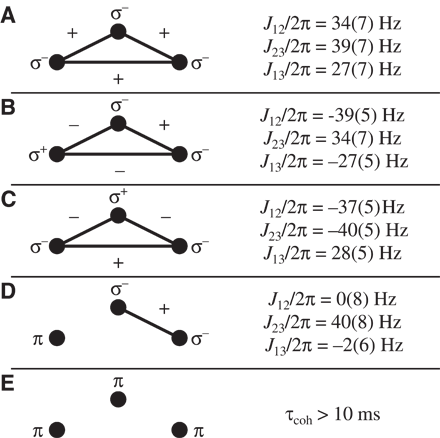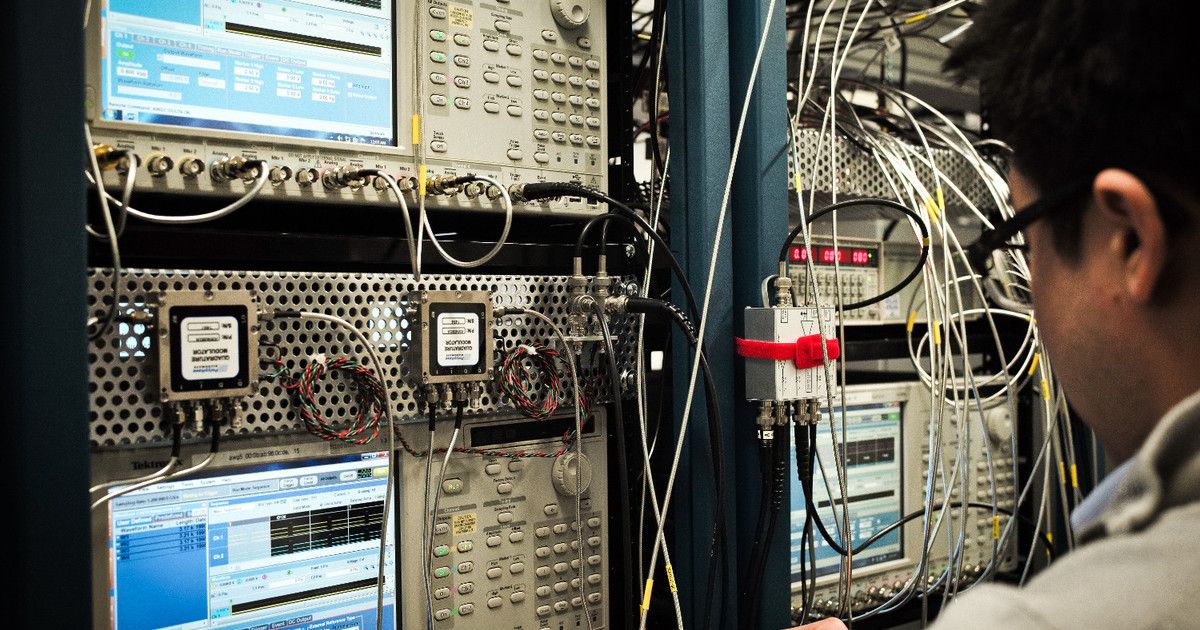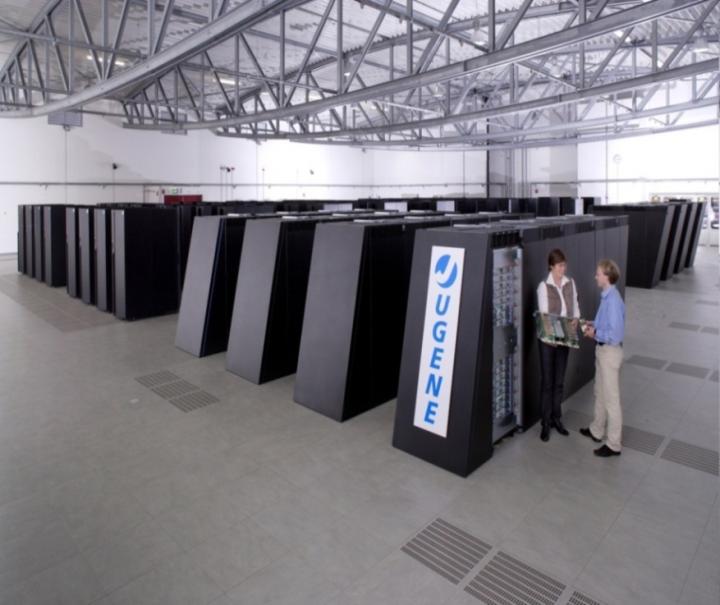A new mathematical model aims to track the activity of Islamic State sympathizers online and determine when groups will turn from talk to action.



Nice.
Networks are mathematical representations to explore and understand diverse, complex systems—everything from military logistics and global finance to air traffic, social media, and the biological processes within our bodies. In each of those systems, a hierarchy of recurring, meaningful internal patterns—such as molecules and proteins interacting inside cells, and capacitors and resistors operating within integrated circuits—determines the functions or behaviors of those systems. The larger and more intricate a system is, however, the harder it is for current network modeling techniques to uncover these patterns and represent them in organized, easy-to-understand ways.
Researchers at Stanford University, funded by DARPA’s Simplifying Complexity in Scientific Discovery (SIMPLEX) program, have made progress in overcoming these challenges through a framework they have developed for identifying and clustering what mathematicians call “motifs”: essential but often obscure patterns within systems that are the building blocks of mathematical modeling and that facilitate the computational representation of complex systems.
A research paper describing the team’s achievement was published in Science (“Higher-order organization of complex networks”). At the heart of the team’s success was the creation of algorithms that can automatically explore and prioritize the hidden patterns in data that are fundamental to explaining network structure and function.

Being treated for high cholesterol with statins is being linked with a reduced risk of death and better survival from four common cancers, a medical conference has heard.
Among the patients in the study, almost 8,000 had lung cancer, 5,500 had breast cancer, 4,600 had prostate cancer and 4,500 had colon cancer, the researchers found. So the researchers think the statin treatment might explain the protective effect, rather than high cholesterol itself.
Data for patients admitted to United Kingdom hospitals between January 1, 2000-March 31, 2013 with the listed cancers were obtained from the Algorithm for Comorbidities, Associations, Length of stay and Mortality (ACALM) clinical database, which also provided data on comorbidities such as high cholesterol; mortality data was obtained from the Office of National Statistics.

More steps forward for QC through the discovery of a versatile effective spin system suitable for quantum simulations and universal quantum computation.
Using trapped atomic ions, we demonstrate a tailored and versatile effective spin system suitable for quantum simulations and universal quantum computation. By simply applying microwave pulses, selected spins can be decoupled from the remaining system and, thus, can serve as a quantum memory, while simultaneously, other coupled spins perform conditional quantum dynamics. Also, microwave pulses can change the sign of spin-spin couplings, as well as their effective strength, even during the course of a quantum algorithm. Taking advantage of the simultaneous long-range coupling between three spins, a coherent quantum Fourier transform—an essential building block for many quantum algorithms—is efficiently realized. This approach, which is based on microwave-driven trapped ions and is complementary to laser-based methods, opens a new route to overcoming technical and physical challenges in the quest for a quantum simulator and a quantum computer.
Listen up all my QC buddies; the air force wants to hear from you. You have QC ideas for fighter jets they want you.
Guess I need to submit them some of mine.
The Air Force wants white papers that describe new ways quantum computing could help achieve its mission, according to an amended Broad Agency Announcement posted Friday. Eventually, the government could provide a test-bed where a contractor might install, develop and test a quantum computing system, according to the announcement.
Last year, the Air Force announced it had about $40 million available to fund research into, and the eventual maintenance and installation of a quantum system — a branch of emerging computing technology that relies on the mechanics of atomic particles to process complex equations.
The Air Force Research Laboratory’s Information Directorate, which focuses on processes such as signal processing, networking technology, cyber research and supercomputing, is collecting those white papers.



Biocomputing/ living circuit computing/ gene circuitry are the longer term future beyond Quantum. Here is another one of the many building blocks.
The tiny molecule responsible for transmitting the genetic data for every living thing on earth could be the answer to the IT industry’s quest for a more compact storage medium. In fact, researchers from Microsoft and the University of Washington recently succeeded in storing 200 MB of data on a few strands of DNA, occupying a small dot on a test tube many times smaller than the tip of a pencil.
The Internet in a Shoebox.
Despite the small space occupied by the DNA strands, the researchers were nonetheless able to successfully store and retrieve high-definition digital video, the top 100 books from Project Guttenberg, and copies of the Universal Declaration of Human Rights in more than 100 languages.

The Defense Advanced Research Projects Agency has finished its work to integrate live data feeds from several sources into the U.S. Space Surveillance Network run by the Air Force in an effort to help space monitoring teams check when satellites are at risk.
SSN is a global network of 29 military radar and optical telescopes and DARPA added seven space data providers to the network to help monitor the space environment under its OrbitOutlook program, the agency said Wednesday.
DARPA plans to test the automated algorithms developed to determine relevant data from the integrated feed in order to help SSA experts carry out their mission.

Great that they didn’t have to use a super computer to do their prescribed, lab controlled experiments. However, to limit QC to a super computer and experimental computations only is a big mistake; I cannot stress this enough. QC is a new digital infrastructure that changes our communications, cyber security, and will eventually (in the years to come) provide consumers/ businesses/ and governments with the performance they will need for AI, Biocomputing, and Singularity.
A group of physicists from the Skobeltsyn Institute of Nuclear Physics, the Lomonosov Moscow State University, has learned to use personal computer for calculations of complex equations of quantum mechanics, usually solved with help of supercomputers. This PC does the job much faster. An article about the results of the work has been published in the journal Computer Physics Communications.
Senior researchers Vladimir Pomerantcev and Olga Rubtsova, working under the guidance of Professor Vladimir Kukulin (SINP MSU) were able to use on an ordinary desktop PC with GPU to solve complicated integral equations of quantum mechanics — previously solved only with the powerful, expensive supercomputers. According to Vladimir Kukulin, personal computer does the job much faster: in 15 minutes it is doing the work requiring normally 2–3 days of the supercomputer time.
The equations in question were formulated in the 60s by the Russian mathematician Ludwig Faddeev. The equations describe the scattering of a few quantum particles, i.e., represent a quantum mechanical analog of the Newtonian theory of the three body systems. As the result, the whole field of quantum mechanics called “physics of few-body systems” appeared soon after this.